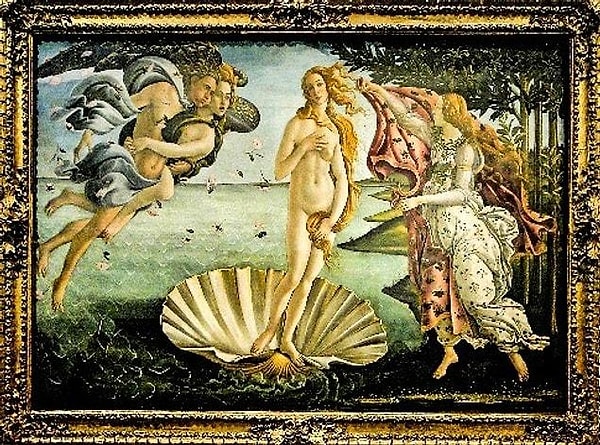The Birth of Venus: Botticelli's Iconic Renaissance Painting
Sandro Botticelli was inspired by many artists and sources. The most important of these is the poem by the famous poet Angelo Poliziano about the Birth of Venus. This poem was taken from an ancient Greek hymn to Aphrodite, the goddess of love and beauty.
Aphrodite is her name in Greek mythology and Venus is her counterpart in Latin mythology.
Born in 1445 in Florence, Sandro Botticelli's real name was Alessandro di Mariano di Vanni Filipepi.

He started his artistic life by learning goldsmithing and received his first art education from his brother Antonio, a goldsmith.
Sandro Botticelli died in 1510. He was buried in the chapel of the Vespucci family in the Ognissanti church in Florence.
The Birth of Venus stands in a very important place in Western art in terms of iconography.

In Greek Civilization, we see that Uranus (the sky) had his own children, creatures called Cyclopes (giants with one eye on their forehead) and Hecatonchires. Uranus begins to fear that his own children will take over his throne and tries to imprison them underground. Gaia cannot accept this. She takes one of her children, Cronus (Zeus' father), and tells him that he must kill his father.
Gaia then makes a scythe from her own breast. Cronus cuts his father's genitals with this scythe and throws it into the sea.

Aphrodite is born in the foam from that sexual organ thrown into the sea. In Western art, Aphrodite is depicted naked because she is the goddess of beauty and love. In Roman times, Aphrodite will transform into Venus.
It depicts the moment when Venus is about to land.

With her body lines reflecting the understanding of beauty of the period, Venus displays a modest stance. She is called the moral Venus in classical sculpture. In this painting, Venus covers her breasts with her hands and her genitals with her hair.
On the one hand, roses, the symbol of Venus, are scattered on it.

In the left corner of the work, Zephyros and Chloris, representing the wind, blow over the gray waters, pushing forward the delicate-edged shell on which Venus sits.
Horai appears on the right side of the painting to dress Venus as she approaches the shore.

Horai is the goddess who symbolizes the seasons in Latin mythology. The dress she is wearing in this painting was prepared for Venus and is decorated with spring flowers, so we can understand that it represents spring.
A garland representing Venus hangs around Horai's neck.

On the body, there is an arch of roses, again symbolizing Venus.
Botticelli's only purpose in making the work was not to depict symbols of Pagan religion or a story from Classical Greece.

In fact, it aims to create a synthesis that brings together pagan beliefs and Christianity, which was particularly prevalent during the Renaissance. Like Venus, Christianity offers beauty to the world. Those who appreciate this beauty are those who follow Christianity in the same parallel.
At that time, Florence brought together Classical Greek and Christian ideas.

The Birth of Venus therefore appears to have a religious purpose.
Moreover, we encounter details in the work that are compatible with this point of view.

The whole painting is dominated by the divine golden light that is reflected in the leaves of the orange trees and plants on the right edge of the work, in the lines of the seashell and in the folds of the clothes, and spreads throughout the work.
Boticelli's 1486 Renaissance painting The Birth of Venus has been in the Uffizi Gallery in Florence for centuries.

Keşfet ile ziyaret ettiğin tüm kategorileri tek akışta gör!


Send Comment